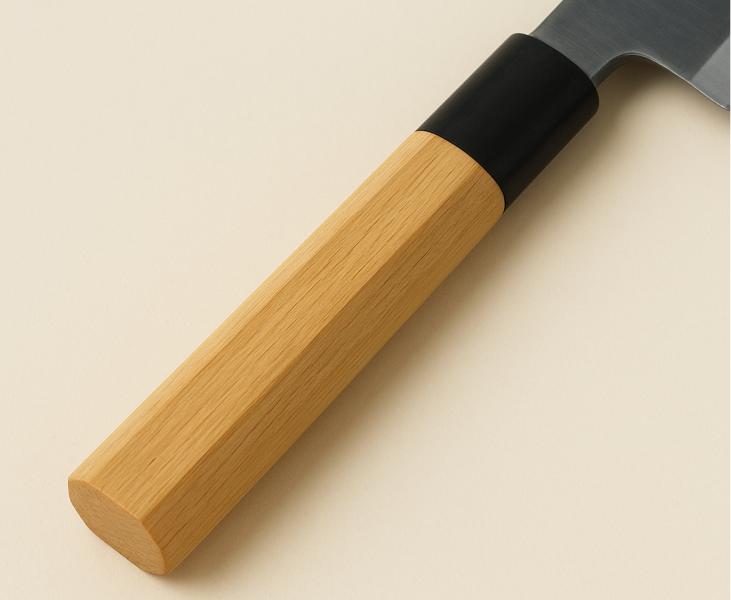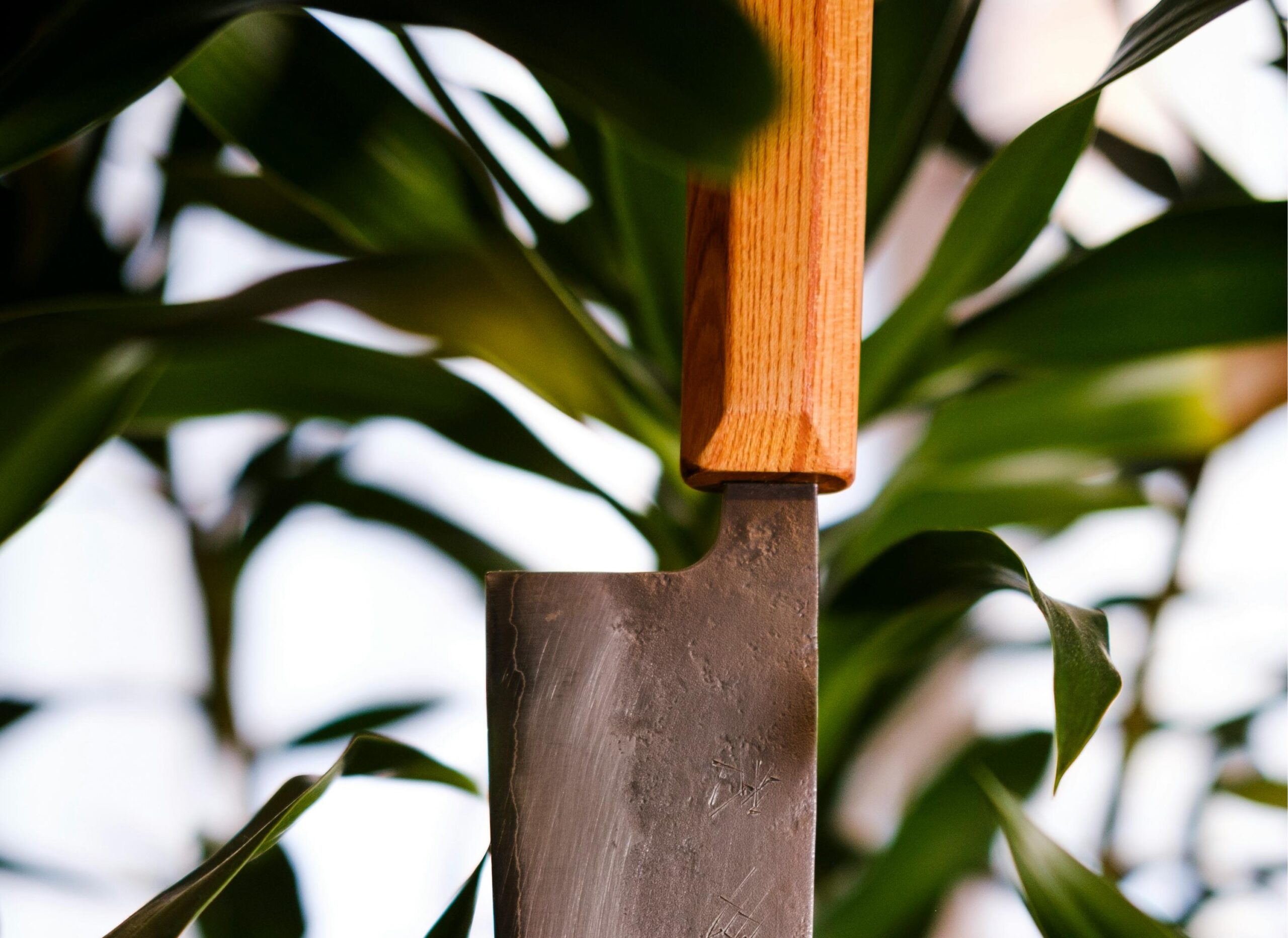Japanese knives have become a staple in kitchens worldwide due to their exceptional sharpness, durability, and craftsmanship. However, beyond the blade, one of the most important features of a Japanese knife is its handle. The handle, or “tsuka,” not only contributes to the knife’s aesthetics but also to its overall performance, comfort, and ease of use. This guide provides an in-depth look at Japanese knife handles, exploring the various materials, types, and important considerations for wholesalers, retailers, and brand owners looking to source knives from China.
Understanding Japanese Knife Handles
The handle of a Japanese knife plays a crucial role in determining the ergonomics and control of the knife. A good handle allows the user to maintain a firm, comfortable grip, even during extended use. This is particularly important for professional chefs or home cooks who rely on knives for precise, repetitive cutting tasks.
Japanese knife handles come in various shapes, sizes, and materials. They are typically designed to balance the knife’s weight, optimize comfort, and provide better maneuverability.
Buy Wholesale Knives and Start Scaling up with Us Today
Contact us and connect with a sales rep to get a free quote.
2. Common Materials for Japanese Knife Handles
The choice of material for a Japanese knife handle greatly impacts both its look and performance. Some materials are better suited for high-end knives, while others offer more affordable yet durable options. Here are the most common materials:
Wood

- Wa (Japanese) Handles: Traditional Japanese knives often feature handles made from wood. Wood offers natural grip and comfort, making it a popular choice among professional chefs.
- Types of Wood:
- Magnolia: Known for its durability and light weight.
- Walnut: Offers a refined, elegant appearance.
- Maple: Known for its hardness and smooth texture.
- Pakka Wood: A composite wood that combines the beauty of natural wood with the durability of synthetic materials.
Wooden handles require regular maintenance to prevent cracking, especially in humid or excessively dry environments.
Synthetic Materials
- Plastic & Resin: These materials are commonly used in budget-friendly Japanese knives. They offer durability, water resistance, and are easy to maintain.
- G-10 and Micarta: High-quality synthetic materials, often used in modern designs. They are highly durable, moisture-resistant, and can be textured for a non-slip grip.
Stainless Steel and Metal
Some Japanese knives feature full-metal handles, which provide a sleek, modern aesthetic. Stainless steel handles are durable and resistant to rust, but they may not offer as comfortable a grip as wooden handles.
Horn and Bone
Historically, horn and bone were used for the handles of certain high-end Japanese knives. They provide a unique, natural appearance but are less common today due to their cost and the difficulty of sourcing these materials sustainably.
Buy Wholesale Knives and Start Scaling up with Us Today
Contact us and connect with a sales rep to get a free quote.
Types of Japanese Knife Handles
Japanese knife handles come in different shapes and styles, each catering to specific use cases or personal preferences. These include:
Traditional “Wa” Handle

- Shape: Typically round, D-shape or octagonal, the “wa” handle is designed to be lightweight and provide a comfortable, ergonomic grip.
- Usage: Found on traditional Japanese knives such as the gyuto, santoku, and yanagiba.
- Pros: Provides a more balanced feel when cutting, especially for precision tasks.
Western-Style Handle
- Shape: These handles are often more robust and ergonomic, with a larger, more contoured design.
- Usage: More commonly found on German-style knives, but some Japanese knife brands offer western-style handles for those seeking a more familiar grip.
- Pros: Offers comfort and a secure grip, especially for people used to western knives.
Full Tang vs. Half Tang
- Full Tang: The tang (the portion of the blade that extends into the handle) runs the full length of the handle, offering maximum strength and balance.
- Half Tang: The tang only extends partway into the handle. While lighter, half tangs may not offer the same durability or balance as full tang knives.
Buy Wholesale Knives and Start Scaling up with Us Today
Contact us and connect with a sales rep to get a free quote.
Critical Design Features of Japanese Knife Handles

Japanese knife handles are engineered for functionality, not just style. These features directly affect your cooking experience:
- Balance: A well-designed handle aligns the knife’s center of gravity near the blade base (for Wa handles) or mid-handle (for Yo handles). This reduces wrist strain during long cutting sessions.
- Length: Standard lengths range from 100mm (4 inches) for small petty knives to 150mm (6 inches) for large gyuto knives. Choose a length that fits your hand size—longer handles suit larger hands, while shorter ones offer more control for small tasks.
- Taper: Wa handles often have a slight taper (wider at the blade, narrower at the end) to keep your grip secure. Yo handles may have a uniform taper for a consistent feel.
- Mekugi (Pin): A small, removable pin that secures the handle to the blade’s tang (the metal extension inside the handle). High-quality knives use 2–3 mekugi for extra stability.
How to Choose the Right Japanese Knife Handle
Follow these steps to select a handle that fits your needs:
- Match to Your Grip Style: If you use a pinch grip (common for sushi or precision cutting), choose a Wa handle. If you prefer a full grip (for chopping vegetables or meat), opt for a Yo or D-shaped handle.
- Consider Your Usage Frequency: For daily use, synthetic or resin handles are low-maintenance. If you value aesthetics and don’t mind upkeep, wood or horn is ideal.
- Check Hand Size: Measure your palm width (across the base of your fingers). Handles wider than 30mm may feel bulky for small hands, while handles narrower than 25mm may lack stability for large hands.
- Prioritize Safety: If you cook in a busy kitchen, choose a handle with a textured surface (e.g., micarta) or wood (natural grip) to prevent slipping when wet.
Buy Wholesale Knives and Start Scaling up with Us Today
Contact us and connect with a sales rep to get a free quote.
Ergonomics and Comfort: Key Considerations
When choosing a knife handle, ergonomics and comfort should be a top priority. The design and material of the handle will influence how the knife feels in hand. A well-designed handle reduces hand fatigue, improves control, and allows for better precision during cutting.
- Grip: Ensure the handle is neither too bulky nor too slim for the user’s hand size.
- Weight Distribution: A well-balanced knife with an ergonomic handle prevents hand strain and allows for more control.
- Non-slip Surface: Handles with textured surfaces or rubberized grips provide extra safety and comfort, especially during extended use.
Maintenance Tips for Japanese Knife Handles
Maintaining the integrity of the handle is as important as maintaining the blade. Here are some tips for ensuring the longevity of your knife handle:
- Wooden Handles: Regularly oil the handle to prevent it from drying out and cracking. Use food-safe mineral oil or a specialized wood conditioner.
- Synthetic Handles: Wipe them down with a damp cloth after each use to remove grease and dirt.
- Avoid Dishwashers: Regardless of material, it’s best to hand wash Japanese knives to prevent unnecessary wear and tear on the handle.
Buy Wholesale Knives and Start Scaling up with Us Today
Contact us and connect with a sales rep to get a free quote.
Why Handle Quality Matters for Wholesalers and Retailers
For wholesalers, retailers, and brand owners, the quality of the knife handle is an essential selling point. Consumers often judge a knife’s performance based on how it feels in hand. Offering knives with high-quality, ergonomic handles can set your brand apart from competitors. As a supplier or retailer, ensuring the handle meets your customers’ expectations is crucial for customer satisfaction and retention.
Frequently Asked Questions (FAQ)
Q1: Which material is best for a Japanese knife handle?
There isn’t a one-size-fits-all answer. It depends on customer preference, price point, and intended use. For a more traditional feel, wooden handles are favored, while synthetic materials offer durability and easy maintenance.
Q2: Can I replace a Japanese knife handle?
Yes, knife handles can often be replaced, although this requires professional skills. If you’re a wholesaler or retailer, you may want to offer handle customization as a service.
Q3: Are Japanese knife handles suitable for left-handed users?
Many traditional Japanese knives come with ambidextrous handles, but for specific knife models, you may want to offer left-handed versions to accommodate all customers.
Q4: How can I ensure the quality of knife handles when sourcing from China?
When sourcing from China, it’s essential to work with reputable manufacturers who offer customization services and provide consistent quality control. Make sure to request samples and verify product certifications.
Request a Free Quote Today
Are you a wholesaler, retailer, or brand owner looking for high-quality Japanese knives sourced directly from China? Leeknives offers wholesale, OEM, and private label services for European and American markets. Our knives feature premium materials, ergonomic designs, and exceptional craftsmanship.
Contact us today for a free quote and start sourcing knives that meet your customers’ expectations!




